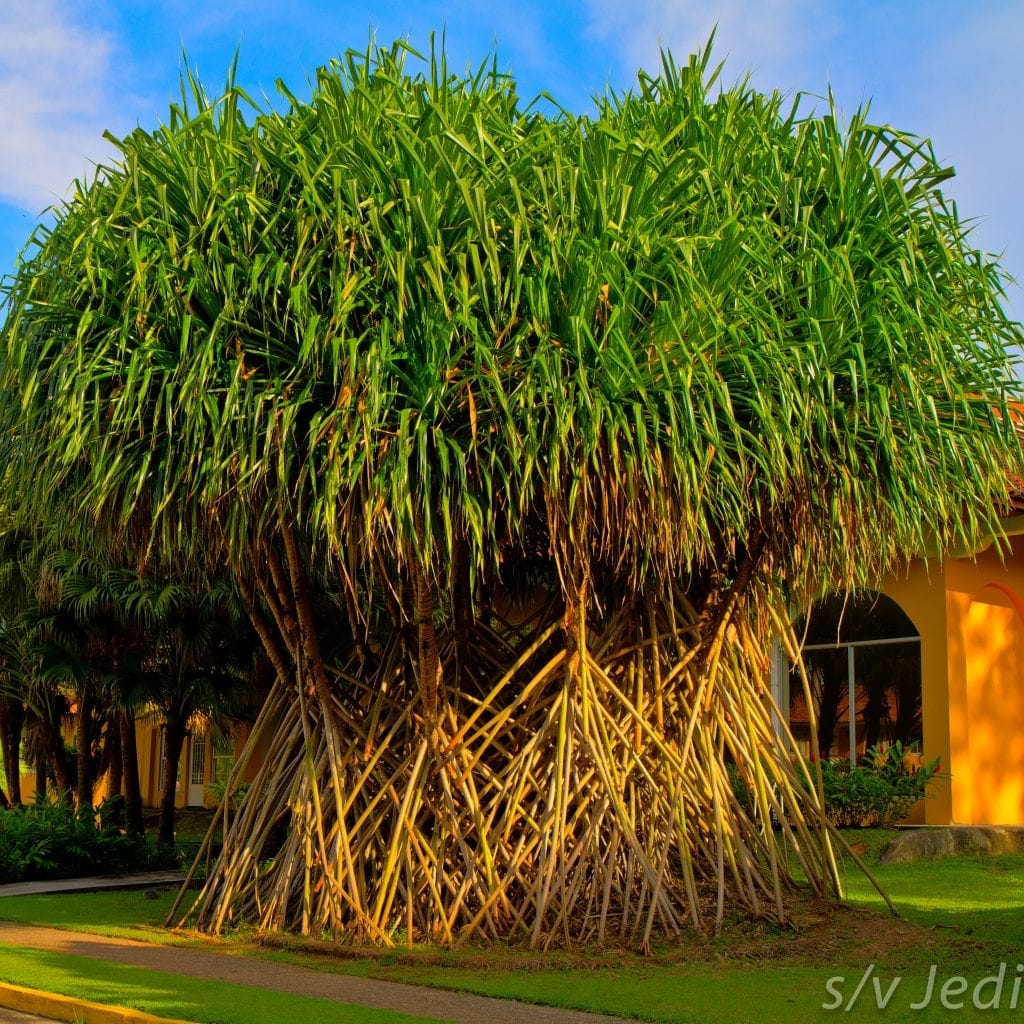Get ready to unravel the captivating secrets of the “walking palm,” a tree shrouded in both fascination and tall tales. Meet Socratea exorrhiza, a botanical wonder from the depths of the rainforest. We’ll delve into the truth behind its legendary ability to walk and uncover the fascinating adaptations that make this tree so extraordinary. Join us as we separate fact from fiction and discover the ecological importance and cultural significance of this rainforest icon.
Can This Palm Tree Really Walk?
The Walking Palm—it’s a name that sparks the imagination, conjuring up images of trees tiptoeing through the rainforest. While the reality isn’t quite as dramatic, the Socratea exorrhiza, commonly known as the Walking Palm, is truly an intriguing tree with some unique tricks up its sleeve… or rather, its roots.
Unlocking the Secrets of the Stilt Roots
The Walking Palm’s roots, instead of being hidden underground like most trees, rise up from the trunk, resembling multiple legs that support the tree. These roots can reach impressive heights, elevating the tree above the forest floor.
But why the stilts? That’s a question that has puzzled scientists for ages. Some believe that these stilt roots provide extra stability, especially in the soggy, uneven terrain of the rainforest. This idea, proposed by E.J.H. Corner, suggests that the stilt roots help the palm navigate the challenging terrain. Others suggest that the roots allow the tree to slowly “walk” towards sunlight by growing new roots in the desired direction while older roots eventually die off.
While the idea of a walking tree is undoubtedly fascinating, it’s important to note that the jury is still out on whether these trees are genuinely mobile. It’s possible that the stilt roots just give the illusion of movement, especially in areas where the ground may shift over time. A 2005 study by biologist Gerardo Avalos, however, suggests that while Socratea exorrhiza may not be winning any races, it does exhibit some degree of root movement, albeit very slow and gradual.
More Than Just a Pretty Root System
Walking or not, this palm is a vital part of the rainforest ecosystem. Those unique stilt roots provide valuable real estate for a whole host of rainforest residents. Ferns, orchids, and even other types of plants happily make their homes on these elevated platforms, creating a miniature hanging garden.
And it’s not just plants that benefit from the Walking Palm’s generosity. Animals like the white-lipped peccary, a type of wild pig, have a particular fondness for the palm’s fruit. As they munch their way through the forest, they spread the seeds far and wide, helping the Walking Palm thrive.
Human Uses and Cultural Significance
The Walking Palm has also played an essential role in the lives of indigenous communities for centuries. Its strong, straight trunk makes for an excellent building material, while those unusual stilt roots have been fashioned into everything from blowguns to medicine.
Facing the Future: Conservation Concerns
Despite its resilience and adaptability, the Walking Palm, like many rainforest species, faces an uncertain future. Deforestation and habitat loss are significant threats to its survival. Conservation efforts are crucial to ensure that this extraordinary tree continues to stand tall in the rainforests for generations to come.
The Walking Palm is a testament to the incredible diversity and ingenuity of nature. It reminds us that there’s still so much to learn about the world around us and that even the most seemingly fantastical stories can hold a grain of scientific truth.
Why is It Called a Walking Tree?
You might’ve heard whispers of a tree that strolls through the rainforest, changing its address as easily as we change our minds. That’s the Socratea exorrhiza, better known by its nickname – the “walking palm”. Now, before you picture a tree picking up its roots and going for a sunset stroll, let’s set the record straight. It doesn’t actually walk in the way we typically think of walking. However, the way it stands on those unusual stilt roots, it sure looks like it could take a step at any moment!
So, what’s the deal with the roots? Well, picture the rainforest floor – not exactly stable real estate, right? It’s damp, things are always shifting, and floods aren’t uncommon. The Socratea exorrhiza’s stilt roots are its secret weapon for thriving in this tricky environment. They act like anchors, giving the tree a solid base even when the ground around it feels like jelly. And here’s the kicker: these roots aren’t just stuck in one spot. As the environment changes and new opportunities for sunlight and nutrients pop up, some experts believe that the walking palm can slowly, ever so gradually, shift its roots to take advantage of these changes. It might even be able to move away from obstacles in its path! While this movement is more of a slow creep than a confident stride, it’s still remarkable.
Think of it like this: imagine you’re standing in a crowded room, and someone spills their drink. You wouldn’t just stand there, right? You’d probably shuffle your feet to avoid the puddle – and in a way, that’s kind of what the walking palm is doing!
While scientists are still unraveling all the mysteries of the Socratea exorrhiza, one thing’s for sure: this tree is a master of adaptation, showing us that even in the wildest corners of the world, life finds a way to thrive.
What are the Uses of Socratea exorrhiza?
We’ve already talked about how cool the “walking palm” is, but the Socratea exorrhiza is more than just a pretty face (or should we say, trunk?). This tree is deeply rooted in the lives of indigenous communities, who’ve figured out how to use it for everything from snacks to medicine. Let’s dive deeper into the practical and cultural roles this special palm plays in the rainforest ecosystem.
Food, But at a Cost:
Imagine a tasty treat growing right from the top of a tree – that’s what the Socratea exorrhiza offers! The young buds at the very top of this palm can be boiled or roasted and enjoyed as a vegetable. However, there’s a catch. Taking these buds is like plucking the heart of the tree; sadly, it means the Socratea exorrhiza won’t survive. It’s a dilemma – delicious food, but at the ultimate price for the tree.
Building a Life From a Tree:
The Socratea exorrhiza’s trunk is like nature’s multi-purpose building material. It’s surprisingly strong for its slender shape. People split the trunk lengthwise to create planks or hollow it out to make sturdy tubes. These natural building blocks then become the framework for houses and other essential structures, providing much-needed shelter and stability in the challenging rainforest environment. Talk about sustainable living!
More Than Just Shelter:
The usefulness of the Socratea exorrhiza’s trunk doesn’t stop at construction. Indigenous communities have a deep understanding of this tree’s properties. They’ve learned that its wood, though lightweight, is incredibly tough. This makes it perfect for crafting hunting spears, essential tools for survival in the rainforest.
Nature’s Medicine Cabinet:
The Socratea exorrhiza is like a living, breathing medicine cabinet for those who know its secrets. The bark and those unique stilt roots, the ones that make it look like it’s walking, have been used in traditional medicine for generations. Think of it: a tree that might help reduce fever, fight malaria, soothe headaches, and even heal skin problems! It’s a testament to the deep connection between the rainforest and the well-being of the people who call it home.
Beyond Practical Uses:
Don’t think the Socratea exorrhiza is all work and no play. With its striking stilt roots and elegant form, it’s also valued as an ornamental plant, adding a touch of the rainforest’s magic to gardens and parks. But its importance goes even deeper than mere aesthetics. In some indigenous communities, the Socratea exorrhiza plays a crucial role in religious ceremonies, its presence adding a spiritual dimension to ancient rituals and beliefs.
A Glimpse into the Unknown:
While we’ve learned a lot about the Socratea exorrhiza, there’s still so much more to discover. Researchers are continually investigating its properties, uncovering new ways it might be used and further understanding its ecological importance. The “walking palm” is a constant reminder that the rainforest holds secrets waiting to be unlocked, secrets that could benefit us all.
Key Points:
- Stilt Roots:
- The Socratea exorrhiza, or Walking Palm, has unique stilt roots that elevate it above the forest floor.
- Theories on Stilt Roots:
- Stability in soggy rainforest terrain
- Possible “walking” by growing new roots towards sunlight
- Debate continues on whether trees are genuinely mobile
- Ecological Importance:
- Stilt roots provide habitat for plants and animals (e.g., ferns, orchids, white-lipped peccary)
- Human Uses:
- Strong trunk used for building materials
- Stilt roots used to make blowguns and medicine
- Conservation Concerns:
- Deforestation and habitat loss threaten the Walking Palm’s survival
- Scientific Significance:
- Challenges traditional assumptions about tree mobility
- Highlights the diversity and creativity of nature
Would you like to know about the largest cockroach in the world? Of course, you do. Check out the scientific name largest cockroach article. Ready yourself to be surprised!
The Unistellar Equinox 2 is a next-generation telescope for amateur astronomers. It’s the first telescope that can take pictures of exoplanets. If you’re interested in astronomy, you should know about this telescope.
















1 thought on “The Walking Palm Fact vs. Fiction: Exploring the Secrets of Socratea Exorrhiza”
Comments are closed.